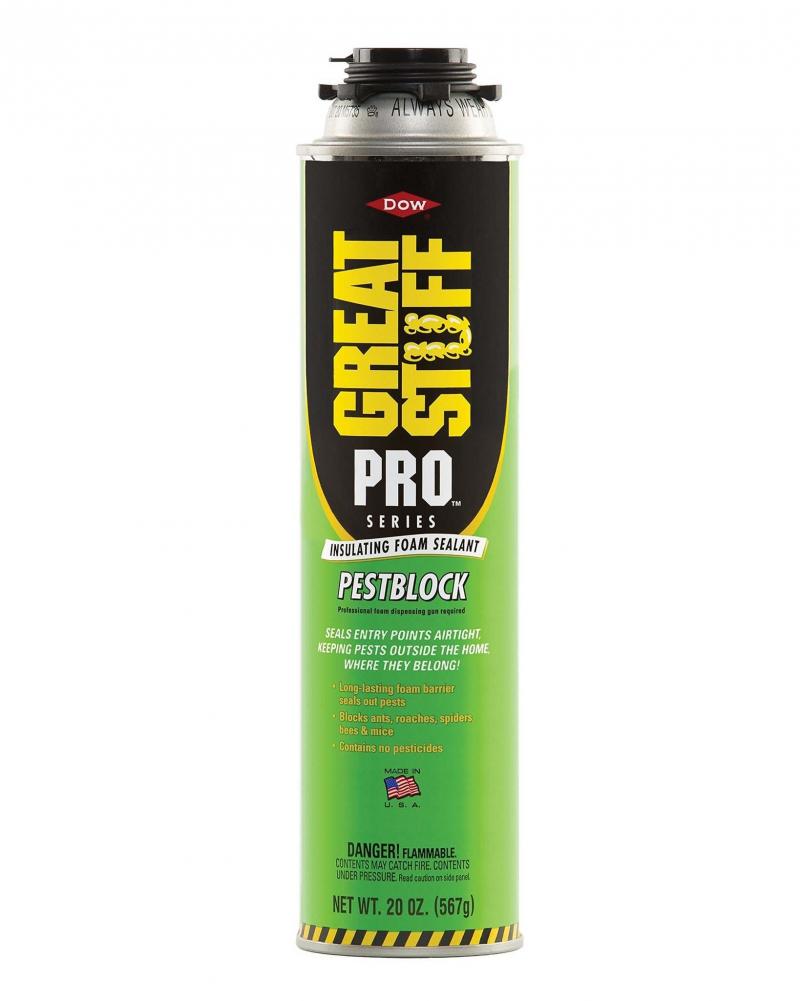
Dow
Since there’s no mixing required, this spray-foam product should plug out mice without damaging a home’s electrical system.
Question: I have a question regarding expanding foam. We have recently had a mouse problem in our house and I am plugging any holes I can find. This includes holes in two by fours through which white-coated electrical wires go from our attached garage to the upstairs area of our house. I have two questions about using a product called Great Stuff pest protection made by Dow. I think it is basically an expanding foam with some kind of pest deterrent added.
Will this product harm the electrical wires? Has it been around long enough for anyone to know long term? Will the foam conduct electricity?
If the wires were harmed over time, I expect replacing them would be very costly, as parts of the house would have to be dismantled to provide access. Any help you can give me with this will be appreciated. I may just stuff the holes with chunks of a fibreglass batt. I gather mice will chew fibreglass, but in this small application, I’m not too concerned and it is easy to check.
— Ian Anderson.
Answer: Having concerns over the effects of various building products on other house components is very proactive before starting repairs or renovations. Polyurethane foam products are ones that have been on the market for decades and have not been found to be problematic, except in some cases of improper mixing and installation.
You are wise to explore the possibility of damage or deterioration to current building materials before applying your mouse-prevention strategy. Especially where electrical components or wiring are involved, ensuring you are not creating a new problem while trying to remediate a current one is a good idea. Modern electrical wiring is part of a very safe system, but only when installed properly and if it’s not damaged. Deterioration or defects in these components can lead to electrical fires and major safety hazards.
To my knowledge, there have only been limited issues with blown-in polyurethane foam insulation, and only with two-part professional products. These chemicals are mixed during application and several issues with deterioration or excessive off-gassing have been linked to improper mixing of components.
Uneven mixtures of the two components can cause improper curing or adhesion. This has led to complaints from homeowners of illness or breathing issues, which typically abate over time. In the worst cases of improper installation, the product had to be completely removed to satisfy the occupants’ concerns and eliminate perceived or real health issues.
The other corresponding issue with bad installations is deterioration and shrinkage, leaving large voids in the insulation. That can lead to air intrusion, condensation and moisture-related issues.
The other issue that is a concern with blown-in foam insulation is excessive heat release. Due to the chemical reaction between the two components in professional-quality, high-density polyurethane foam, the finished product is very exothermic. In layman’s terms that means that the foam mixture gives off a large amount of heat during the mixing and installation process. Because of this property, only moderate thicknesses (up to three inches) can be applied at a time.
Once the product cures, typically overnight or after a 24-hour period, additional foam may be applied to completely fill cavities, if required. The gases released during application may be noxious or toxic, so installers must wear proper respirators for safety. Once cured, the off-gassing is minimal and no longer considered to be a safety hazard.
The good news that should accompany these concerns is that these issues do not apply to the single-component foam you are planning to use. That product has lower density than the professional two-part material and is slower to cure and harden. Those properties prevent both the overheating and toxic off-gassing common with the professional-quality foams. Also, because the cured foam is essentially polyurethane, a common household plastic, it is a good insulator. It will not conduct electricity and should not harm the wiring or the sheathing surrounding it. In fact, the spray-in type foams in aerosol cans found at various retailers have been designed for specific use with many modern building products. Most will adhere to almost any surface and provide an excellent way to plug small to moderate holes due to the expansive nature of the product.
The only item I am unsure of is the actual rodent-prevention properties of the product you have chosen. I have personally used some of the other Great Stuff products and only have one caution. When exposed to sunlight or other UV sources, the foam will turn brown and deteriorate. If it is applied in an area where this will be a factor, it should be painted or covered to prevent damage over time. Also, mice may be able to chew or scratch their way through the foam, especially if damaged by UV light, so reinforcing it may help you achieve your goal.
Because mice seem to love tunnelling and chewing through fibreglass insulation, I would avoid your last suggestion for using that material to plug the holes.
An effective option commonly used is steel wool, but I would not suggest this where there are live wires, in case the sheathing is damaged. Other synthetic or plastic wools may be a better choice and could be installed loosely in the openings before covering with the liquid foam. Alternatively, covering the hardened foam with duct or plastic tape may provide some advantage. That would help protect the foam surface and make it easier to identify any areas damaged by lingering rodents.
Using common expanding polyurethane foam to plug small openings in your home or garage to prevent mouse intrusion is a very easy and effective way to minimize this problem. While you are prudent in being concerned over long-term issue with compatibility, there should be nothing to worry about with this well-tested and designed household building product.
Ari Marantz is the owner of Trained Eye Home Inspection Ltd. and the past president of the Canadian Association of Home & Property Inspectors — Manitoba (cahpi.mb.ca). Questions can be emailed to the address below. Ari can be reached at 204-291-5358 or check out his website at trainedeye.ca.
trainedeye@iname.com



